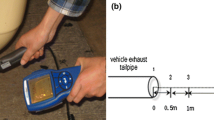Abstract
The impact of the street configurations on pollutants dispersion from vehicles exhausts within urban canyons was numerically investigated using a computational fluid dynamics (CFD) model. Three-dimensional flow and dispersion of gaseous pollutants were modeled using standard κ − ε turbulence model, which was numerically solved based on Reynolds-averaged Navier–Stokes equations by the commercial CFD code FLUENT. The concentration fields in the urban canyons were examined in three cases of street configurations: (1) a regular-shaped intersection, (2) a T-shaped intersection and (3) a Skew-shaped crossing intersection. Vehicle emissions were simulated as double line sources along the street. The numerical model was validated against wind tunnel results in order to optimize the turbulence model. Numerical predictions agreed reasonably well with wind tunnel results. The results obtained indicate that the mean horizontal velocity was very small in the center near the lower region of street canyon. The lowest turbulent kinetic energy was found at the separation and reattachment points associated with the corner of the down part of the upwind and downwind buildings in the street canyon. The pollutant concentration at the upwind side in the regular-shaped street intersection was higher than that in the T-shaped and Skew-shaped street intersections. Moreover, the results reveal that the street intersections are important factors to predict the flow patterns and pollutant dispersion in street canyon.
Similar content being viewed by others
References
Ahmadi, G., & Li, A. (2000). Computer simulation of particle transport and deposition near a small isolated building. Journal of Wind Industrial Aerodynamics, 84, 23–46. doi:10.1016/S0167-6105(99)00048-3.
Assimakopoulos, V. D., Apsimon, H. M., & Moussiopoulos, N. (2003). A numerical study of atmospheric pollutant dispersion in different two-dimensional street canyon configurations. Atmospheric Environment, 37, 4037–4049. doi:10.1016/S1352-2310(03)00533-8.
Baik, J.-J., Kang, Y.-S., & Kim, J.-J. (2007). Modeling reactive pollutant dispersion in an urban street canyon. Atmospheric Environment, 41, 934–949. doi:10.1016/j.atmosenv.2006.09.018.
Baik, J.-J., & Kim, J.-J. (1999). A numerical study of flow and pollutant dispersion characteristics in urban street canyons. Journal of Applied Meteorology, 38, 1576–1589. doi:10.1175/1520-0450(1999)038<1576:ANSOFA>2.0.CO;2.
Chan, A. T., Au, W. T. W., So, E. S. P. (2003). Strategic guidelines for street canyon geometry to achieve sustainable street air quality part II: Multiple canopies and canyons. Atmospheric Environment, 37, 2761–2772. doi:10.1016/S1352-2310(03)00252-8.
Chan, T. L., Dong, G., Leung, C. W., Cheung, C. S., & Hung, W. T. (2002). Validation of a two-dimensional pollutant dispersion model in an isolated street canyon. Atmospheric Environment, 36(5), 861–872. doi:10.1016/S1352-2310(01)00490-3.
FLUENT Inc. (2005). FLUENT 6.2.16 user manual.
Hassan, A. A., & Crowther, J. M. (1998). Modeling of fluid flow and pollutant dispersion in a street canyon. Environmental Monitoring and Assessment, 52, 281–297.
Huang, H., Akustu, Y., Arai, M., & Tamura, M. (2000). A two-dimensional air quality model in an urban street canyon: Evaluation and sensitivity analysis. Atmospheric Environment, 34, 689–698. doi:10.1016/S1352-2310(99)00333-7.
Jaňour, Z., Bezpalcova, K., Yassin, M. F., Brych, K., Dittrt, F., & Dietrich, F. (2007). A potential risks in industrial sites—wind tunnel. In 6th international conference on urban air quality, Cyprus, 27–29 March.
Kim, J.-J., & Baik, J.-J. (2003). Effects of inflow turbulence intensity on flow and pollutant dispersion in an urban street canyon. Journal of Wind Industrial Aerodynamics, 91, 309–329. doi:10.1016/S0167-6105(02)00395-1.
Koutsourakis, N., Neofytou, P., Venetsanos, A. G., & Bartzis, J. G. (2005). Parametric study of the dispersion aspects in a street-canyon area. International Journal of Environment and Pollution, 25(1/2/3/4), 155–163.
Launder, B. E., & Spalding, D. E. (1974). The numerical computation of turbulent flows. Computer Methods in Applied Mechanics and Engineering, 3, 269–289. doi:10.1016/0045-7825(74)90029-2.
Leitl, B. M., & Meroney, R. N. (1997). Car exhaust dispersion in a street canyon: Numerical critique of a wind tunnel experiment. Journal of Wind Industrial Aerodynamics, 67–68, 293–304. doi:10.1016/S0167-6105(97)00080-9.
Mensink, C., Lewyckyj, N., & Janssen, L. (2002). A new concept for air quality modeling in street canyons. Water Air and Soil Pollution Focus, 2, 339–349. doi:10.1023/A:1021303922031.
Neofytou, P., Venetsanos, A. G., Rafailidis, S., & Bartzis, J. G. (2006). Numerical investigation of the pollution dispersion in an urban street canyon. Environmental Modelling & Software, 21, 525–531. doi:10.1016/j.envsoft.2004.08.012.
Patankar, S. V. (1980). Numerical heat transfer and fluid flow. New York: McGraw-Hill.
Sahm, P., Louka, P., Ketzel, M., Guillouteau, E., & Sini, J.-F. (2002). Intercomparison of numerical of numerical urban dispersion models. Part I: Street canyon and single building configurations. Water Air and Soil Pollution Focus, 2, 587–601. doi:10.1023/A:1021349232026.
Sini, J.-F., Anquentin, S., & Mestayer, P. G. (1996). Pollutant dispersion and thermal effects in urban street canyons. Atmospheric Environment, 30, 2659–2677. doi:10.1016/1352-2310(95)00321-5.
Xie, X., Huang, Z., & Wang, J.-S. (2005). Impact of building configuration on air quality in street canyon. Atmospheric Environment, 39, 4519–4530. doi:10.1016/j.atmosenv.2005.03.043.
Author information
Authors and Affiliations
Corresponding author
Additional information
This article has been retracted at the request of the Editor-in-Chief. A complaint received against it indicated that significant sections of the text showed a similarity with the authors own papers published previously. The two papers are:
1. Impact of street intersections on air quality in an urban environment, Mohamed F. Yassin, R. Kellnerovác, and Z. Jaňour, Volume 42, Issue 20, June 2008, Pages 4948-4963. Atmospheric Environment
2. Impact of height and shape of building roof on air quality in urban street canyons, Mohamed F. Yassin, Volume 45, Issue 29, September 2011, Pages 5220-5229, Atmospheric Environment
In addition, Mr. Mohamed F. Yassin published this paper in Environmental Monitoring and Assessment without the consent of co-authors Zbynek Janour and Radka Kellnerova. Given the copyright and authorship issues involved, the Environmental Monitoring and Assessment article in question is being retracted.
An erratum to this article is available at http://dx.doi.org/10.1007/s10661-016-5698-0.
About this article
Cite this article
Yassin, M.F., Kellnerová, R. & Jaňour, Z. RETRACTED ARTICLE: Numerical simulation on pollutant dispersion from vehicle exhaust in street configurations. Environ Monit Assess 156, 257–273 (2009). https://doi.org/10.1007/s10661-008-0482-4
Received:
Accepted:
Published:
Issue Date:
DOI: https://doi.org/10.1007/s10661-008-0482-4




